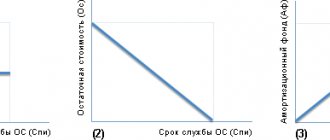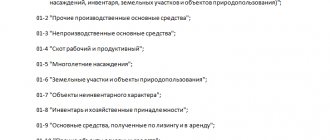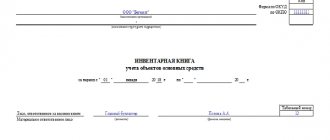As you know, a property is transferred at least twice under a lease agreement.
The first time is the provision of an asset by the lessor to the lessee for temporary use. The second time is the return of property to the landlord from the tenant upon expiration of the lease agreement.
It should also be understood that the object of rental relations can only be such a thing that is not consumed as it is usefully used and does not significantly change its original characteristics.
Thus, in the production and economic sphere, fixed assets (fixed assets) are very often rented. Accounting for relevant transactions is mandatory for both the lessor and the lessee. Accounting for lease of fixed assets from the tenant.
However, standard accounting procedures for each of the parties to the contract will have their own characteristics.
Transfer of OS: documentation
The legal fact of transfer of a leased fixed asset is usually formalized by an acceptance certificate. This document, as you know, is an integral annex (addition) to the lease agreement.
This act clearly certifies and subsequently confirms the fulfillment by the parties - the lessor and the lessee - of the obligations to transfer and accept the relevant property.
The requirement for the parties to draw up such paper is expressly established by the Civil Code of the Russian Federation for immovable fixed assets and the legislation on accounting for other objects (for example, movable assets).
Thus, any business transactions must be documented and reflected in the accounting system.
For a document certifying the fact of transfer of a property from the lessor to the lessee, no standard uniform template is provided.
If we are talking about the lease of fixed assets, such an act can be drawn up in free form.
However, this paper must necessarily contain a full set of necessary details regulated by the norms of 402-FZ (accounting law).
In addition, the parties to the lease agreement have the right to use standard forms for certificates of delivery and acceptance of fixed assets, approved by the official statistical agency for fixed assets (for example, form OS-15).
Accounting with the lessor upon delivery
If the terms of the fixed asset lease agreement do not provide for the purchase of the property by the lessee, the lessor remains the owner of the leased asset throughout the entire validity period of this document.
Consequently, property transferred for temporary use, as a rule, is reflected on the balance sheet of the lessor.
There are, however, the following exceptions to this rule:
- Property is the subject of a financial lease (in other words, leasing), the terms of which may imply that the corresponding object is reflected both on the balance sheet of the lessor (lessor) and on the balance sheet of the lessee (lessee). The specific option is determined by the parameters of the concluded agreement at the discretion of the parties.
- The object of lease relations is the enterprise as an integral property complex, which is reflected in the balance sheet of the tenant.
Accounting rules provide for separate accounting of fixed assets provided for temporary use to third parties.
Analytical accounting of fixed assets allows you to separate leased objects from the lessor's own assets.
Fixed assets acquired or created specifically for lease to third parties are subject to accounting within the OS on accounting account 03. This principle is established by standard PBU-6/01.
Assets that are reflected not only in account 01, but also in accounting account 10 can be transferred for temporary operation.
To make it easier to control the movement of assets, the lessor organization can open subaccounts for the appropriate purpose to the accounting accounts by which property is accounted for (accounts 10,03,01).
For example, subaccounts “Property provided for rent”, “Own property”.
The question often arises as to whether the lessor should transfer an asset in accounting from accounting account 01 to accounting account 03, if this asset was previously acquired for use in production, but was subsequently leased to a third party.
Experts and regulatory agencies unanimously believe that this is not necessary. In accounting account 03, only those fixed assets that were initially acquired by the owner for their subsequent rental should be taken into account.
Accordingly, an asset purchased for use in production, but leased to a third party, should continue to be accounted for in accounting account 01 with a separate sub-account opened for this purpose.
If fixed assets are intended for rental, but are temporarily not used in income-generating activities, this is not a reason for their exclusion from depreciable property. But are these depreciation charges always taken into account as expenses? The rules for calculating depreciation are known to every accountant. But sometimes situations arise when it is not entirely clear how to apply them.
For example, an organization is engaged in leasing out its own property and keeps records of such fixed assets in account 03 “Income-generating investments in material assets.” However, there are periods when the property is not leased. In particular, the building may be put into operation, but tenants have not yet been found, or the relationship has not yet been formalized. The following situation is also possible: the property was transferred by the tenant due to the end of the lease term, but the new tenant is temporarily absent, or the property has been decided to be sold. Is it possible to calculate depreciation during such periods? After all, the property is not used to generate income and is idle. Does a company that leases property have the right to apply bonus depreciation?
The essence of the problem
If we turn directly to the text of the tax legislation, it lists only four situations when property ceases to be considered depreciable. All of them are listed in paragraph 3 of Article 256 of the Tax Code, which states that fixed assets are excluded from depreciable property: 1) transferred (received) under contracts for free use; 2) transferred by decision of the organization’s management to conservation for a period of more than three months; 3) which, by decision of the management of the organization, are undergoing reconstruction and modernization for a period of more than 12 months. The fourth situation concerns ships registered in the Russian International Register of Ships for the period of their stay in the said register.
According to the Russian Ministry of Finance, in all other cases the accrual of depreciation should not stop. This point of view was repeatedly expressed in letters from the financial department. In particular, such clarifications were given in relation to the period during which property is temporarily not used in the production of goods (works, services) for technological or economic reasons *(1); production equipment that is idle due to a lack of orders due to the economic crisis (but has not been put into storage)*(2), etc.
The Moscow Department of the Federal Tax Service of Russia also indicates that the list of business transactions in which the accrual of depreciation is temporarily suspended is closed. Therefore, in other cases, for example, during the period of downtime of depreciable property caused by production needs, depreciation does not stop *(3).
Despite these clarifications, inspectors sometimes exclude depreciation charges from calculating the tax base for income taxes if the property temporarily does not generate income. However, the courts usually make decisions in favor of the companies*(4).
Let's look at examples from judicial practice that are of interest in the context of this article.
Thus, according to the case materials * (5), the company, according to the transfer and acceptance certificate dated February 26, 2002, received property as a contribution to the authorized capital, which was put into operation.
In accordance with the company's letter dated December 28, 2004, this property was supposed to be rented out. Meanwhile, the equipment was not rented out and was mothballed according to the order of the manager dated June 30, 2005. During the period from February 1 to June 30, 2005, the taxpayer accrued depreciation on this property.
The courts have established and the case materials have confirmed that the disputed property was not used by the company due to its temporary downtime, which is part of the production cycle. Under such circumstances, the courts concluded that it was justified for the company to take into account depreciation when calculating income tax.
Similar reasoning is contained in another court ruling * (6).
From the materials of this case it follows that under the lease agreement dated September 29, 2002, the taxpayer leased the disputed premises, which were returned to the lessor on August 31, 2003. Subsequently, due to the absence of a new tenant, the company decided to sell the above buildings.
The court concluded that the company rightfully expensed the amount of accrued depreciation, since the mere fact of non-use of property for a short period of time does not mean that it will subsequently not participate in production activities.
From the given examples of judicial practice, we can conclude that if a company has acquired property for rent, but this property has not yet been leased (a tenant has not been found or contractual relations are in the process of being formalized), then it has the right to take into account depreciation charges when calculating tax income tax bases.
This conclusion also follows indirectly from the letter of the Ministry of Taxes and Taxes of Russia in 2004*(7). It noted that the organization takes into account expenses for profit tax purposes both in the period when it receives income and in the period in which it does not receive income, provided that the activities of the organization as a whole are aimed at generating income. It is necessary to take into account that any production cycle contains both active and preparatory parts, the costs of which are taken into account regardless of the duration of each of these parts.
Thus, searching for a tenant and drawing up an agreement can be considered a preparatory part of the production cycle, which does not deprive the taxpayer of the right to take into account expenses in the form of depreciation of property that will be leased. So, let's summarize the above. Downtime of property is not a basis for its exclusion from depreciable property. However, the legality of recognizing expenses in the form of depreciation of a fixed asset that is temporarily idle depends on the validity of the reasons that caused this idle time (for example, the latter must be part of the production cycle). This is the position of officials; arbitration practice confirms these conclusions.
Solution
In 2013, the Federal Tax Service of Russia sent a letter *(8) for use in the work of the tax authorities, which contained the official point of view of the Ministry of Finance of Russia *(9) on the issue of calculating depreciation in relation to temporarily unused property.
The logical chain of reasoning of the financiers given in this letter is as follows.
In tax accounting, the use of depreciable property in income-generating activities begins from the moment it is put into operation. It is from this moment that taxpayers are given the right to reduce its value through depreciation.
According to the provisions of Articles 259.1 and 259.2 of the Tax Code, depreciation is terminated in the event of physical disposal or complete write-off of the value of the depreciable property. The list of fixed assets excluded from depreciable property is established by paragraph 3 of Article 256 of the Code. However, these provisions do not provide for a requirement to stop accruing depreciation if there is no income from the use of depreciable property for any period of time.
On this basis, the letter in question from the Russian Ministry of Finance made the following conclusion: “the Code does not provide for the arbitrary exclusion of property from depreciation, including based on the criterion of temporary non-receipt of income.” Thus, at present, tax authorities must actually adhere to the approach developed by judicial practice. If the inspectors violated this instruction and made a decision to assess additional income tax, then this can be reported directly to the Federal Tax Service of Russia * (10).
As an exception. It is necessary to pay special attention to the clause that is present in one of the decisions of the Federal Antimonopoly Service of the Moscow District * (11).
The court cited the definition of depreciable property and made the following conclusion: “It does not follow from this definition of depreciable property that the property must constantly be used to generate income. The tax period for income tax in accordance with Article 285 of the Tax Code of the Russian Federation is a calendar year. In other words, the income must be received during the tax period.”
Therefore, if during the tax period the taxpayer does not receive income from the property, the court may find it unlawful to take into account expenses in the form of depreciation charges when calculating the tax base for income tax. For example, in our case, non-receipt of income may occur due to a long search for a tenant or a search for a buyer if a decision is made to sell a fixed asset (previously leased).
Let us recall that in the case of applying the linear method, depreciation accrual ceases from the 1st day of the month following the month * (12): 1) when the cost of the depreciable property was completely written off 2) or when this object was removed from the taxpayer’s depreciable property for any reason reasons. Thus, if the property is returned by the tenant at the end of the lease period and is in the process of being sold (for example, a fixed asset was transferred for sale under a commission agreement), depreciation on it is not suspended. The cessation of depreciation should occur on the 1st day of the month following the month when the object was removed from the depreciable property, that is, sold.
Depreciation bonus
The issue of accounting for bonus depreciation deserves special attention. Tax legislation allows a taxpayer to include in the expenses of the reporting (tax) period expenses for capital investments in the amount of no more than 10 (30) percent of the original cost of fixed assets * (13).
Expenses in the form of bonus depreciation are recognized in the reporting period in which the start date of depreciation (the date of change in the original cost) of fixed assets falls *(14).
In one of the letters of the Ministry of Finance of Russia * (15), the following conclusion was made: “equipment acquired by an organization for lease and listed on the balance sheet of the lessor organization in account 03 “Income-generating investments in material assets” cannot be considered for the purposes of the Code as capital investments, expenses for which the taxpayer has the right to include as expenses in the amount of no more than 10 percent of the original cost of fixed assets in accordance with clause 1.1 of Art. 259 of the Code."
This conclusion seems very controversial, since tax legislation does not link the right to a depreciation bonus with the account number in which the property is accounted for. In addition, profitable investments in material assets in accounting are precisely the fixed assets that are used to provide services - providing property for rent * (16).
We have no information about the existence of tax disputes on this issue. If the price of the issue is high, then you can send a corresponding request to the tax authority. We believe that it is likely that you will receive a favorable answer, since previously the Russian Ministry of Finance took a similar position in relation to property intended for transfer to the lessee * (17), but subsequently changed its opinion * (18). The Federal Tax Service of Russia also issued corresponding clarifications for an unlimited number of people*(19).
Let's illustrate the above with an example.
Example Initial data: 1. Costs for the acquisition of fixed assets: - in accounting - 1,000,000 rubles; — in tax accounting — 1,000,000 rubles. 2. Useful life: - in accounting - 20 years (240 months); — in tax accounting — 20 years (240 months) 3. According to the accounting policy for tax accounting purposes, the organization applies a depreciation bonus in the amount of 10% (including to fixed assets accounted for in account 03 “Income-earning investments in tangible assets” ). 4. The property was purchased on 09/05/2014 and is ready for use for its intended purpose, but a tenant was found and an agreement was concluded with him only in November 2014. Let us determine the procedure for reflecting fixed assets in accounting and tax accounting. In September 2014: Debit 03 Credit 08 - 1,000,000 rubles. — fixed assets are accepted for accounting at historical cost. In tax accounting, the initial cost of the fixed asset will be formed in the amount of 900,000 rubles, i.e. minus the depreciation bonus (1,000,000 rubles - 1,000,000 rubles x 10%)*(20). Starting from October 2014: Debit 20 (26) Credit 02 - 4166.67 rubles. (RUB 1,000,000: 20 years: 12 months) - depreciation has been calculated. In tax accounting in October 2014, it is necessary to recognize in indirect expenses a depreciation bonus in the amount of 100,000 rubles (1,000,000 rubles x 10%). At the same time, depreciation in the amount of 3,750 rubles begins to be calculated in tax accounting. (RUB 900,000: 20 years: 12 months).
If the property will be leased only in January 2015, then it is unsafe to begin depreciation in tax accounting in October 2014. In such circumstances, it is better to defer the calculation of depreciation until the next tax period - 2015.
Accounting entries
Repayment of the cost of fixed assets that are the property of the enterprise, including those that are leased, is carried out through depreciation.
The income of the lessor of fixed assets (receipts of lease payments) and its expenses are taken into account depending on whether the provision of assets for rent is a direction (subject) of the organization’s regular activities.
Is the subject of the enterprise's activities
If the rental of fixed assets is related to the activity of the lessor enterprise, the corresponding income/expenses are taken into account as income/expenses of ordinary activities.
Lessor costs may include repair costs, depreciation and other relevant expenses. For taxation of profits, such income/expenses must be classified as income/expenses from sales.
To account for these income/costs in this situation, you should use the 90-account (“Sales”).
The costs of the lessor company due to the rental of fixed assets are accumulated in the debit of accounting accounts (44,26,23,20), which take into account expenses.
At the end of the month, the following posting is generated:
| Operation (description) | Account debit | Account credit |
| Write off accumulated costs in one amount | 90/2 | 44,26,23,20 |
The income of the owner of fixed assets - receipts of rental payments - is accounted for on the credit side of accounting account 90 with the following entry:
| Operation (description) | Account debit | Account credit |
| Receipts of rental payments | 76 | 90/1 |
| VAT accrual on rental payments | 90/2 | 68 |
By the end of the reporting period, the lessor, using accounting account 90, determines the final financial result (profit/loss), which is recorded in accounting account 99.
Does not relate to the type of activity of the organization
If the transfer of fixed assets for rent is not part of the ordinary activities of the lessor company, the corresponding income/expenses should be classified as other income/expenses.
For tax purposes, such income/expenses are considered non-operating income/expenses.
Rental transactions are reflected in accounting account 91, known as “Other income/expenses”.
On the debit of account 91, expenses on leased assets are taken into account, and on the credit of the same account, income (in other words, rental income) is taken into account.
Typical transactions of the OS lessor:
| Operation (description) | Account debit | Account credit |
| The object is transferred for rent | 01 | 01 |
| The rent payment is calculated | 76 | 91/1 |
| VAT calculation | 91/2 | 68 |
| Depreciation calculation for fixed assets | 26,23,20 | 02 |
| Writing off depreciation as costs for the lessor | 91/2 | 26,23,20 |
| Payment for OS rental is credited from the tenant | 51 | 76 |
| OS lessor's profit | 91/9 | 99 |
Depreciation on delivered objects
General rules establish the obligation of the lessor of a fixed asset to charge depreciation on the corresponding objects provided for temporary use.
The following situations are exceptions:
- The object of the lease is the enterprise as an integral property complex. In this situation, depreciation is charged by the lessee.
- A financial lease (in other words, leasing) agreement establishes the obligation of the lessee (lessee) to depreciate the relevant asset.
| Operation (description) | Account debit | Account credit |
| Depreciation is accrued on fixed assets (it is a subject of economic activity) | 20 | 02 (with corresponding subaccount) |
| Depreciation is calculated on fixed assets (not a subject of economic activity) | 91/2 | 02 (with corresponding subaccount) |
What conditions must the tenant comply with in order to amortize the inseparable improvements?
Depreciable property is recognized as capital investments in the form of inseparable improvements in leased fixed assets.
Inseparable improvements are of a capital nature if they are associated with reconstruction, modernization, or technical re-equipment of depreciable property.
At the same time, the costs of inseparable improvements can be taken into account when calculating income tax only if the lessor has given his consent to their implementation (clause 1 of Article 256 of the Tax Code).
In the absence of such consent, costs cannot be taken into account (letter of the Ministry of Finance of Russia dated December 17, 2015 No. 03-07-11/74085).
If the lessor does not reimburse the cost of capital investments in the leased property, the lessee has the right to depreciate them during the term of the lease agreement. The amount of depreciation is calculated based on the useful life established by the Classification of fixed assets for a leased object or capital investments in this object (clause 1 of Article 258 of the Tax Code).
Thus, the lessee has the right to take into account depreciation charges subject to the following conditions:
- inseparable improvements were made with the consent of the lessor;
- the cost of inseparable improvements is not reimbursed to the tenant;
- expenses for inseparable improvements are documented and economically justified.
Previously on the topic:
The landlord does not amortize free integral improvements
Property tax on capital investments in leased property





